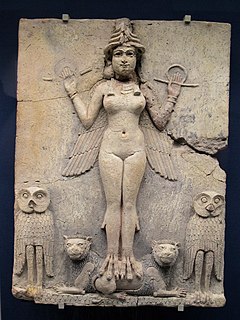Related Research Articles

Sexual attraction is attraction on the basis of sexual desire or the quality of arousing such interest. Sexual attractiveness or sex appeal is an individual's ability to attract the sexual or erotic interests of other people, and is a factor in sexual selection or mate choice. The attraction can be to the physical or other qualities or traits of a person, or to such qualities in the context where they appear. The attraction may be to a person's aesthetics or movements or to their voice or smell, among other things. The attraction may be enhanced by a person's adornments, clothing, perfume or style. It can be influenced by individual genetic, psychological, or cultural factors, or to other, more amorphous qualities. Sexual attraction is also a response to another person that depends on a combination of the person possessing the traits and on the criteria of the person who is attracted.

Masculinity is a set of attributes, behaviors, and roles associated with men and boys. Although masculinity is largely thought to be socially constructed, research indicates that some behaviors considered masculine are biologically influenced. To what extent masculinity is biologically or socially influenced is subject to debate. It is distinct from the definition of the biological male sex, as both males and females can exhibit masculine traits.

Femininity is a set of attributes, behaviors, and roles generally associated with women and girls. Although femininity is socially constructed, research indicates that some behaviors considered feminine are biologically influenced. To what extent femininity is biologically or socially influenced is subject to debate. It is distinct from the definition of the biological female sex, as both males and females can exhibit feminine traits.

Physical attractiveness is the degree to which a person's physical features are considered aesthetically pleasing or beautiful. The term often implies sexual attractiveness or desirability, but can also be distinct from either. There are many factors which influence one person's attraction to another, with physical aspects being one of them. Physical attraction itself includes universal perceptions common to all human cultures such as facial symmetry, sociocultural dependent attributes and personal preferences unique to a particular individual.

The waist-hip ratio or waist-to-hip ratio (WHR) is the dimensionless ratio of the circumference of the waist to that of the hips. This is calculated as waist measurement divided by hip measurement. For example, a person with a 30″ (76 cm) waist and 38″ (97 cm) hips has a waist-hip ratio of about 0.78.
Human male sexuality encompasses a wide variety of feelings and behaviors. Men's feelings of attraction may be caused by various physical and social traits of their potential partner. Men's sexual behavior can be affected by many factors, including evolved predispositions, individual personality, upbringing, and culture. While most men are heterosexual, significant minorities are homosexual or varying degrees of bisexual.
Gender has been an important theme explored in speculative fiction. The genres that make up speculative fiction (SF), science fiction, fantasy, supernatural fiction, horror, superhero fiction, science fantasy and related genres, have always offered the opportunity for writers to explore social conventions, including gender, gender roles, and beliefs about gender. Like all literary forms, the science fiction genre reflects the popular perceptions of the eras in which individual creators were writing; and those creators' responses to gender stereotypes and gender roles.

A man is an adult male human. Prior to adulthood, a male human is referred to as a boy.

Sexual selection in humans concerns the concept of sexual selection, introduced by Charles Darwin as an element of his theory of natural selection, as it affects humans. Sexual selection is a biological way one sex chooses a mate for the best reproductive success. Most compete with others of the same sex for the best mate to contribute their genome for future generations. This has shaped our evolution for many years, but reasons why humans choose their mates are hardly understood. Sexual selection is quite different in non-human animals than humans as they feel more of the evolutionary pressures to reproduce and can easily reject a mate. The role of sexual selection in human evolution has not been firmly established although neoteny has been cited as being caused by human sexual selection. It has been suggested that sexual selection played a part in the evolution of the anatomically modern human brain, i.e. the structures responsible for social intelligence underwent positive selection as a sexual ornamentation to be used in courtship rather than for survival itself, and that it has developed in ways outlined by Ronald Fisher in the Fisherian runaway model. Fisher also stated that the development of sexual selection was "more favourable" in humans.
Age disparity in sexual relationships is the difference in ages of individuals in sexual relationships. Concepts of these relationships, including what defines an age disparity, have developed over time and vary among societies. Differences in age preferences for mates can stem from evolutionary mating strategies and age preferences in sexual partners may vary cross-culturally. There are also social theories for age differences in relationships as well as suggested reasons for 'alternative' age-hypogamous relationships. Age-disparity relationships have been documented for most of recorded history and have been regarded with a wide range of attitudes dependent on sociocultural norms and legal systems.
Role congruity theory proposes that a group will be positively evaluated when its characteristics are recognized as aligning with that group's typical social roles. Coined by Eagly and Karau (2002), prejudice toward female leaders occurs because inconsistencies exist between the characteristics associated with the female gender stereotype and those associated with the typical leadership.
Gender advertisement refers to the images in advertising that depict stereotypical gender roles and displays. Gender displays are used heavily in advertising in order to establish the role of one gender in relation with the other, and some scholars argue that advertisers are obsessed with gender. Advertisers focus on gender relationships, because people define themselves by gender, and gender can be "communicated at a glance", making it easy for advertisers to use this theme in their work. The effects of advertising on body image have been studied by researchers, ranging from psychologists to marketing professionals. "These days we know that the media and body image are closely related. Particularly, the body image advertising portrays affects our own body image. Of course, there are many other things that influence our body image: parenting, education, intimate relationships, and so on. The popular media does have a big impact, though." This is because thousands of advertisements contain messages about physical attractiveness and beauty, examples which include commercials for clothes, cosmetics, weight reduction, and physical fitness. Researchers have conducted studies in an attempt to see if such advertisements have effects on teenage body image, and what those effects might be. Scholars from the University of Colorado and Millsaps College conducted research that concluded that the images, symbols, and practices of the media are used by the audiences they reach and that media does, in important ways, have the “last word” concerning the way individuals feel about themselves. Women account for 85% of consumer purchases.
Transmisogyny is the intersection of transphobia and misogyny. Transmisogyny includes misogyny, sexism, transphobia, and cissexism toward trans women and transfeminine people that may not be experienced by cisgender women or trans men.
Mate preferences in humans refers to why one human chooses or chooses not to mate with another human and their reasoning why. Men and women have been observed having different criteria as what makes a good or ideal mate. A potential mate's socioeconomic status has also been seen as having a noticeable effect, especially in developing areas where social status is more emphasized.
Lookism is a term that describes the discriminatory treatment of people who are considered physically unattractive. It occurs in a variety of settings, including dating, social environments, and workplaces. Lookism has received less cultural attention than other forms of discrimination and typically does not have the legal protections that other forms often have, but it is still widespread and significantly affects people's opportunities in terms of romantic relationships, job opportunities, and other realms of life.
Internalized sexism takes the form of sexist behaviors and attitudes enacted by women toward themselves or other women and girls. On a larger scale, internalized sexism falls under the broad topic of internalized oppression, which "consists of oppressive practices that continue to make the rounds even when members of the oppressor group are not present".

In evolutionary psychology and behavioral ecology, human mating strategies are a set of behaviors used by individuals to select, attract, and retain mates. Mating strategies overlap with reproductive strategies, which encompass a broader set of behaviors involving the timing of reproduction and the trade-off between quantity and quality of offspring.
Media and gender refers to the relationship between mass media and gender, and how gender is represented within media platforms. These platforms include but are not limited to film, radio, television, advertisement, social media, and video games. Initiatives and resources exist to promote gender equality and reinforce women's empowerment in the media industry and representations. For example, UNESCO, in cooperation with the International Federation of Journalists, elaborated the Gender-sensitive Indicators for Media contributing to gender equality and women's empowerment in all forms of media.

Female intrasexual competition is competition between women over a potential mate. Such competition might include self-promotion, derogation of other women, and direct and indirect aggression toward other women. Factors that influence female intrasexual competition include the genetic quality of available mates, hormone levels, and interpersonal dynamics.
In feminist theory, heteropatriarchy or cisheteropatriarchy, is a socio-political system where (primarily) cisgender males and heterosexuals have authority over cisgender females and over other sexual orientations and gender identities. It is a term that emphasizes that discrimination of women and LGBTQ people has the same sexist social principle.
References
- ↑ Phyllis W. Berman, Barbara A. O'Nan and Wayne Floyd, The double standard of aging and the social situation: Judgments of attractiveness of the middle-aged woman, SEX ROLES Volume 7, Number 2, 87-96
- ↑ Mary Harris, Growing Old Gracefully: Age Concealment and Gender, Journal of Gerontology: Psychological Sciences, Volume 49, Number 4, pages 149-158
- ↑ Francine M. Deuisch, Carla M. Zalenski, Mary E. Clark, Is There a Double Standard of Aging, Journal of Applied Social Psychology, Volume 16, Issue 9, pages 771–785, December 1986